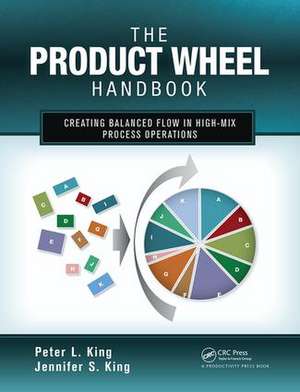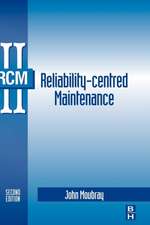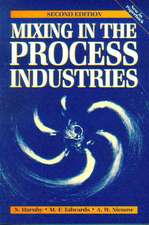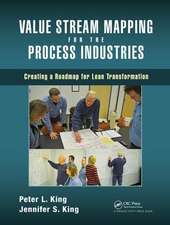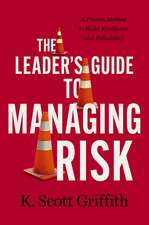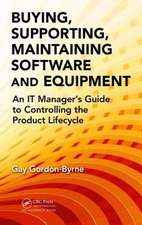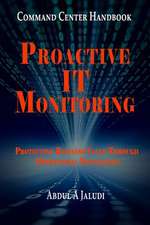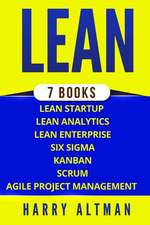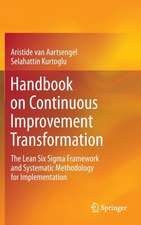The Product Wheel Handbook: Creating Balanced Flow in High-Mix Process Operations
Autor Peter L. Kingen Limba Engleză Hardback – 4 apr 2018
| Toate formatele și edițiile | Preț | Express |
|---|---|---|
| Paperback (1) | 379.06 lei 3-5 săpt. | +49.44 lei 6-12 zile |
| Taylor & Francis – 26 apr 2013 | 379.06 lei 3-5 săpt. | +49.44 lei 6-12 zile |
| Hardback (1) | 877.66 lei 6-8 săpt. | |
| Taylor & Francis – 4 apr 2018 | 877.66 lei 6-8 săpt. |
Preț: 877.66 lei
Preț vechi: 1179.36 lei
-26% Nou
Puncte Express: 1316
Preț estimativ în valută:
167.94€ • 175.70$ • 139.51£
167.94€ • 175.70$ • 139.51£
Carte tipărită la comandă
Livrare economică 03-17 aprilie
Preluare comenzi: 021 569.72.76
Specificații
ISBN-13: 9781138409439
ISBN-10: 113840943X
Pagini: 219
Dimensiuni: 210 x 280 x 18 mm
Greutate: 0.57 kg
Ediția:1
Editura: Taylor & Francis
Colecția Productivity Press
Locul publicării:Oxford, United Kingdom
ISBN-10: 113840943X
Pagini: 219
Dimensiuni: 210 x 280 x 18 mm
Greutate: 0.57 kg
Ediția:1
Editura: Taylor & Francis
Colecția Productivity Press
Locul publicării:Oxford, United Kingdom
Public țintă
Academic and PostgraduateRecenzii
Peter L. and Jennifer S. King, authors of The Product Wheel Handbook, have provided excellent strategies for implementing product wheels and improving an existing product wheel process. ... Written in a clear, concise manner, this book is a how-to manual for product wheel design, implementation, maintenance, and continuous improvement. The authors integrate principles with concepts in a way that is practical and easy to understand. ... If you are tasked to implement product wheels or want to learn more about how they can lead to improvements, you will find The Product Wheel Handbook a valuable reference.
—Book review by Alan R. Leigh CSCP, CPIM, and Randy Woehl appearing in APICS, January 2014
Peter King continues to be a thought leader in the spread of advanced manufacturing practices throughout the process industries. His product wheel concepts and practices are an excellent resource for plants with multiple products sharing the operating assets.
—Ray Floyd, Shingo Prize-winning author of Liquid Lean and member of IndustryWeek's Manufacturing Hall of Fame
The authors have a gift for writing well, in a way that will keep the reader connected throughout this excellent work. It flows through the methodology in a well structured and logical way and could only be written by someone who has lived through product wheel implementation many times ... definitely a must-read for any Lean practitioner.
—Henrique Fagundes, Senior Project Manager, DuPont
The product wheel is a true landmark in the management and organization of the workplace. All manufacturing operations searching for a way to organize and level the factory should have this book.
—Cash Powell, Jr., Editorial Board, Target Magazine; Association for Manufacturing Excellence; Lead Consultant, Center for Competitive Change, University of Dayton
A clearly written guide to designing and improving product wheels ... . Pete and Jennifer King take you through a logical step-by-step process without ever resorting to simplistic recipes. This book will be valuable to businesses where both pull and push systems apply. Highly recommended!
—Peter C. Compo, Director of Integrated Business Management, DuPont
The Dow Chemical Company has used The Product Wheel Handbook for good communication and collaboration between functions. We highly recommend this book as it is a logical layout with step by step implementation instructions. ... Not only did our processes become more efficient but our teams were able to understand a new process that they can apply in different applications in the work process. We recommend this book to any company looking to apply lean concepts specifically in the process industry and also for leaders who are looking for applications to help explain such processes to their employees.
—Martin Fernandes, Supply Chain Innovation Director, Dow Chemical
—Shannon Hemmelgarn, Supply Chain Business Planner, Dow Chemical
The views expressed in this review are of the authors alone and do not represent the views of The Dow Chemical Company
—Book review by Alan R. Leigh CSCP, CPIM, and Randy Woehl appearing in APICS, January 2014
Peter King continues to be a thought leader in the spread of advanced manufacturing practices throughout the process industries. His product wheel concepts and practices are an excellent resource for plants with multiple products sharing the operating assets.
—Ray Floyd, Shingo Prize-winning author of Liquid Lean and member of IndustryWeek's Manufacturing Hall of Fame
The authors have a gift for writing well, in a way that will keep the reader connected throughout this excellent work. It flows through the methodology in a well structured and logical way and could only be written by someone who has lived through product wheel implementation many times ... definitely a must-read for any Lean practitioner.
—Henrique Fagundes, Senior Project Manager, DuPont
The product wheel is a true landmark in the management and organization of the workplace. All manufacturing operations searching for a way to organize and level the factory should have this book.
—Cash Powell, Jr., Editorial Board, Target Magazine; Association for Manufacturing Excellence; Lead Consultant, Center for Competitive Change, University of Dayton
A clearly written guide to designing and improving product wheels ... . Pete and Jennifer King take you through a logical step-by-step process without ever resorting to simplistic recipes. This book will be valuable to businesses where both pull and push systems apply. Highly recommended!
—Peter C. Compo, Director of Integrated Business Management, DuPont
The Dow Chemical Company has used The Product Wheel Handbook for good communication and collaboration between functions. We highly recommend this book as it is a logical layout with step by step implementation instructions. ... Not only did our processes become more efficient but our teams were able to understand a new process that they can apply in different applications in the work process. We recommend this book to any company looking to apply lean concepts specifically in the process industry and also for leaders who are looking for applications to help explain such processes to their employees.
—Martin Fernandes, Supply Chain Innovation Director, Dow Chemical
—Shannon Hemmelgarn, Supply Chain Business Planner, Dow Chemical
The views expressed in this review are of the authors alone and do not represent the views of The Dow Chemical Company
Cuprins
Introduction: Why Product Wheels? Process Industry Challenges; Product Wheel Basics; The Problem: Production Sequencing, Campaign Sizing, Production Leveling; The Solution-Product Wheels; The Product Wheel Design and Implementation Process; Step 1: Begin with an Up-to-Date, Reasonably Accurate VSM; Step 2: Decide Where to Use Wheels to Schedule Production; Step 3: Analyze Products for a Make-to-Order Strategy; Step 4: Determine the Optimum Sequence; Step 5: Analyze the Factors Influencing Overall Wheel Time; Step 6: Put It All Together-Determine Overall Wheel Time and Wheel Frequency for Each Product; Step 7: Arranging Products-Balancing the Wheel; Step 8: Plotting the Wheel Cycles; Step 9: Calculate Inventory Requirements; Step 10: Review with Stakeholders; Step 11: Assign Responsibility for Allocating PIT Time; Step 12: Revise the Scheduling Process; Step 13: Develop an Implementation Plan; Step 14: Develop a Contingency Plan; Step 15: Get All Inventories in Balance; Step 16: Confirm Wheel Performance-Put an Auditing Process in Place; Step 17: Put a Plan in Place to Rebalance the Wheel Periodically; Case Studies and Examples
Notă biografică
Peter L. King Lean Dynamics LLC, Newark, Delaware, USA, Jennifer S. King
Descriere
This title describes the product wheel design process, a proven technique for dealing with all of the issues related to multiple product situations. It walks the reader through a logical, detailed, step by step, process for designing and implementing the PW technique.
